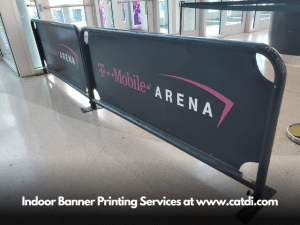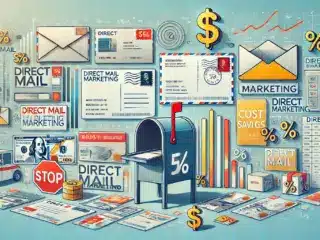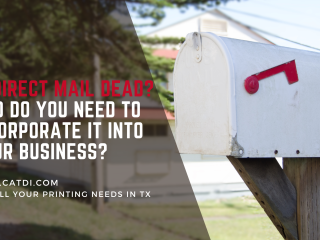Last Updated on September 16, 2025 by Carlos Alonso
8 Benefits of Combining Print‑on‑Demand with EDDM for Small Campaigns
The benefits of combining print on demand with EDDM (Every Door Direct Mail) show up in the little things you don’t notice at first. You don’t overprint. You don’t stash a ton of extras in a closet. You just make what you need and send it out – easy as that. And for anyone running a small campaign, this combination quietly takes the pressure off.
Intrigued? We thought so. That is why we have compiled 8 clear ways this approach makes small campaigns work better. On top of that, you will also get 8 practical strategies to plan and run your campaign with POD and EDDM together.
8 Proven Benefits Of Combining Print‑on‑Demand With Every Door Direct Mail

Here are 8 reasons why combining print-on-demand with EDDM works so well for local outreach.
1. Cost-Effective Marketing Campaigns With Minimal Upfront Investment
The problem with traditional print ads is that you are forced to order thousands of pieces just to get a decent price per unit. Most of them are unused or end up in the trash. With print-on-demand, you cut that problem out entirely – you only print what you need right now.
Pair that with EDDM, and you don’t have to buy or rent a mailing list. The United States Postal Service (USPS) already has the delivery routes mapped out for you. For a small campaign, that means you stay lean and avoid the financial dead weight that usually eats into ROI.
Here’s how this marketing strategy works for local businesses:
- A salon can print 300 postcards for one postal route instead of overordering 5,000.
- A gym can test two different offers in two neighborhoods without paying extra for printing twice.
You spend less upfront and keep cash free for other parts of the campaign, including your ongoing digital efforts.
2. Hyper-Local Targeting Without A Mailing List
Buying a mailing list sounds good until you realize how messy it gets – outdated addresses, duplicates, and flat-out irrelevant. With EDDM, you skip all that. USPS delivers to every home or business on the route you choose.
For a small campaign, that is priceless. You decide exactly where your message goes – down to a few streets if you want. And when you tie this to print-on-demand, you can easily change what you are sending for different routes without ordering thousands of extra copies.
That means every drop feels tailored to the target audience you actually want to reach, not just whoever happens to be on a rented list.
Think about it like this:
- A pizza shop can target every house within one ZIP code.
- A cleaning service wants to target only residential routes, skipping businesses – that is an option too.
3. Fast Turnaround Time
One of the biggest headaches in small campaigns is timing. You get an idea for a promotion, but by the time the printed materials are ready to mail, the moment has passed. Print-on-demand cuts production down to just what you need, and EDDM works on USPS schedules that are already set.
That means you can move quickly from design to delivery. In many cases, you can have your postcards printed and on their way to mailboxes in under a week.
This is especially useful for:
- Seasonal events (back-to-school specials, holiday sales, local festivals).
- Time-sensitive offers (flash discounts, “this weekend only” promos).
4. Easy Personalization For Different Neighborhoods
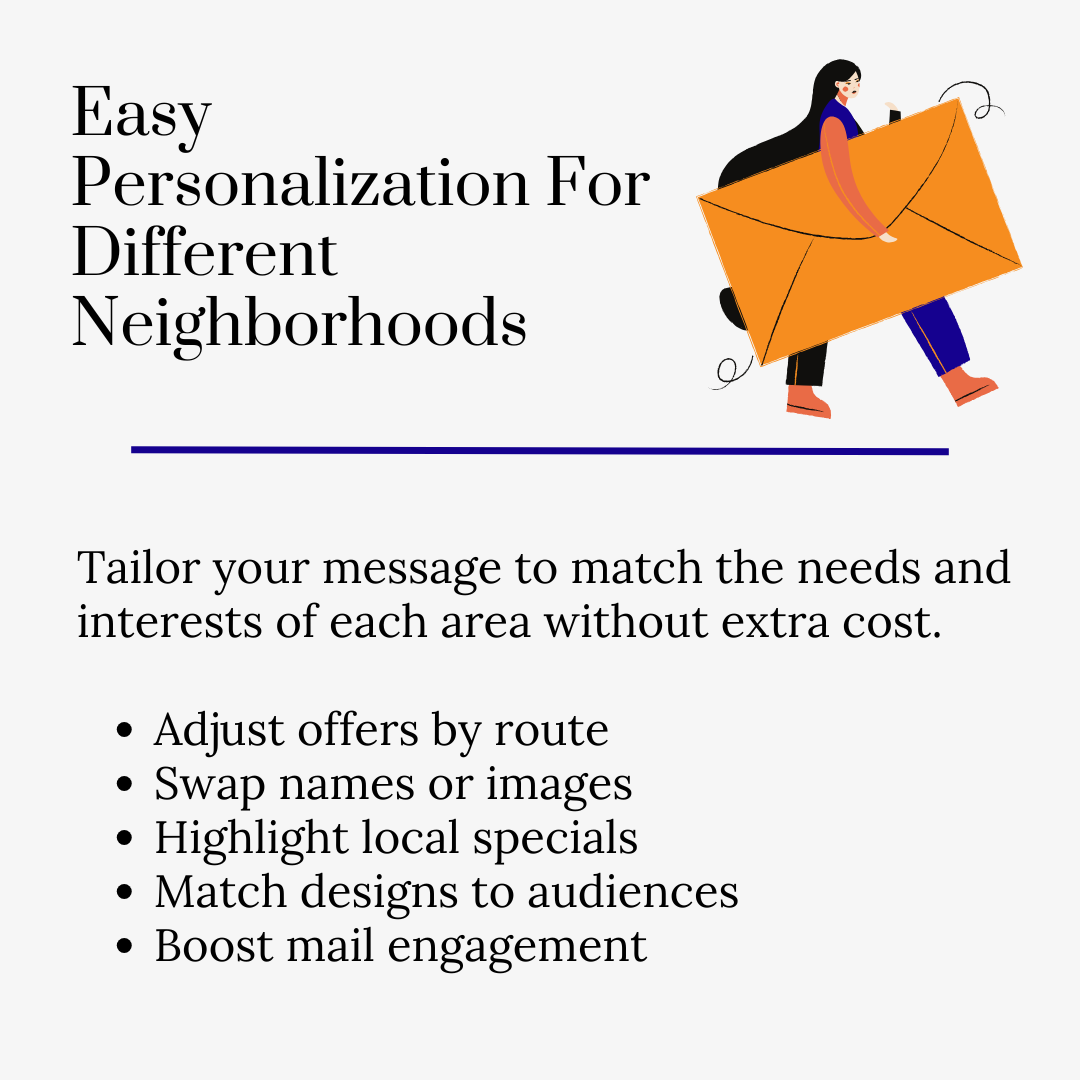
Not every neighborhood responds the same way. Maybe one neighborhood wants discounts, while another prefers community involvement. With print-on-demand, you can easily change your design or offer for each route.
And with variable data printing (VDP), you can even swap out details like names, images, or codes to make each piece more personal. Because you are not stuck with a massive bulk order, tweaking your campaign doesn’t cost extra.
Here’s how it works in practice:
- A restaurant can promote “kids eat free” in family-heavy neighborhoods and “happy hour deals” in areas with more young professionals.
- A landscaping service can highlight “lawn care specials” in suburban areas and “snow removal” in regions that need it during winter.
This makes your mail more relevant and increases the chances people actually read it instead of tossing it. And since EDDM gives you the delivery routes, it is easy to match each version with the right area.
5. Reduced Printing Waste & Inventory Risks
Nothing wastes a marketing budget faster than ordering 5,000 postcards and realizing you will only use half. Traditional print advertising locks you into bulk orders, and whatever doesn’t get used either clogs up storage or ends up in the trash. With print-on-demand, you only print what the campaign calls for.
EDDM adds another layer of control – you know exactly how many homes or businesses are on a given postal route before you place your order. If a route has 325 addresses, you print 325 pieces. This way, you can start with one or two routes. If the response looks good, print more and expand.
6. Enhanced Tracking & Performance Insights
A lot of people assume mail can’t be tracked. That is only true if you don’t set it up right. With POD and EDDM, you build the system into your mailers, just like in digital marketing campaigns.
Over time, you will know which neighborhoods are generating leads and which ones aren’t pulling their weight. For small campaigns, that insight keeps you from repeating mistakes and lets you focus on what works.
7. Increased Brand Visibility In Local Communities
People don’t always buy the first time they see you. Sometimes they need 3 or 4 touches before they act. Every Door Direct Mail campaigns put you in mailboxes repeatedly, and POD makes it easy to refresh your design each round so you don’t look stale.
This is how local visibility builds:
- First mailing → your local customer base notices your name.
- Second mailing → they start to recognize you.
- Third mailing → you are familiar enough that they consider you when they need your product or service.
It is about planting a flag in the neighborhood. When your piece keeps showing up in the same community, your business feels present and established, even if you are still small. This visibility also reinforces the consistency people see in both print and online ads, and makes your brand harder to forget.
8. Flexible Experimentation With Designs & Offers
The old way of commercial printing kills experimentation. Once you have printed thousands of pieces, you are stuck with that design, whether it works or not. With the POD + EDDM combination, you can split your runs or change your messaging to test what works best.
Some real ways small campaigns can use this:
- One neighborhood gets “$10 off,” another gets “Buy 1 Get 1 Free.” See which converts better.
- Bright colors vs. minimal design. Do people respond more to loud or clean?
- “Call us today” vs. “Visit our website.” The tracking methods you set up (codes, QR, numbers) will show what works.
Because you are printing in smaller batches, the cost of testing is minimal. And the payoff is huge – you find out what actually works instead of guessing.
How To Plan A Small Campaign By Combining Print‑on‑Demand With EDDM
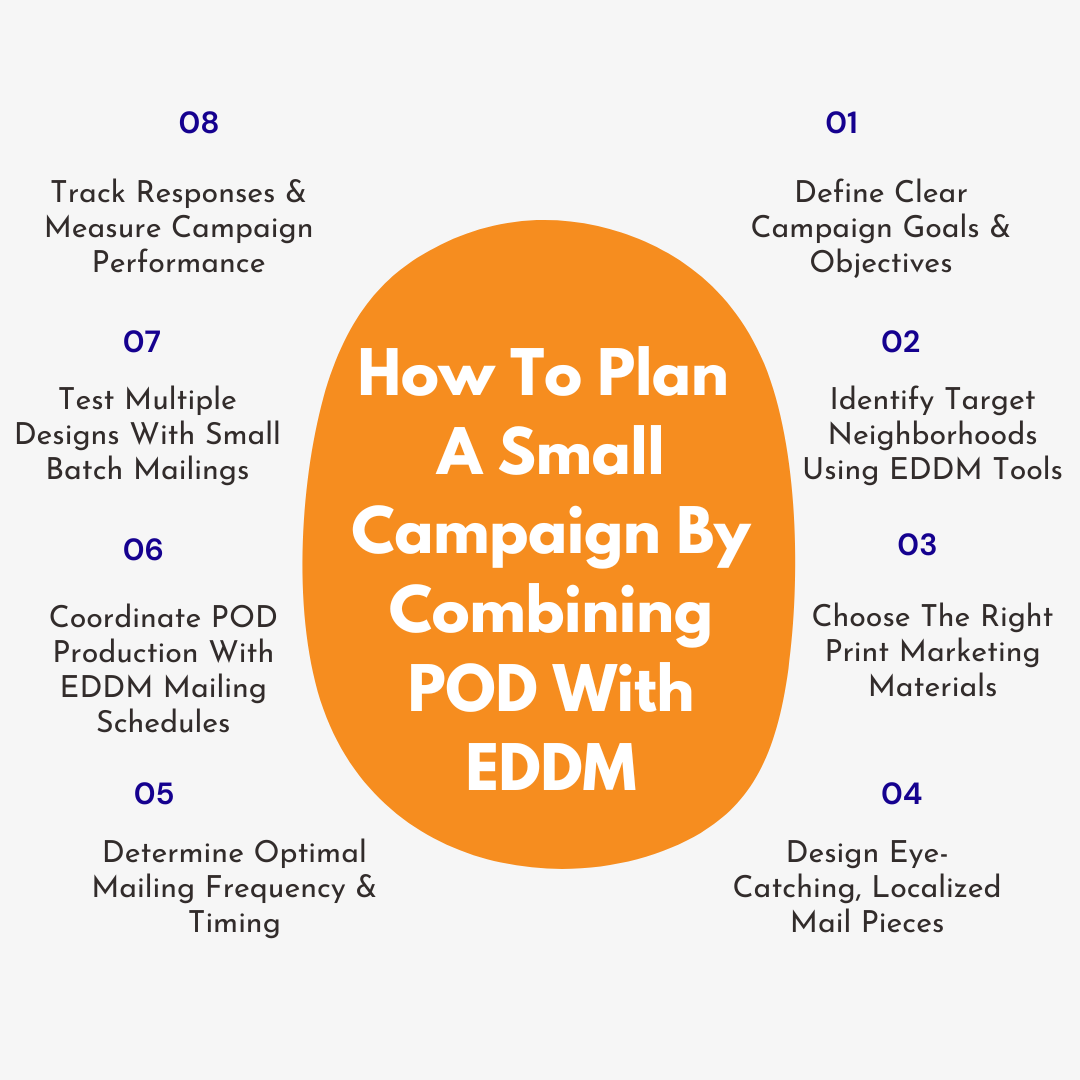
Here are 8 proven strategies that show you exactly how to plan and run a print-on-demand + EDDM campaign that is targeted and effective.
1. Define Clear Campaign Goals & Objectives
Before you start designing postcards or picking routes, you need clarity on what you want out of the campaign. Too many small campaigns fail because they are vague. And no, “get more customers” isn’t a goal.
Get specific:
- Do you want 20 new leads within a month?
- Are you pushing a seasonal promotion for a set weekend?
- Is the goal to introduce your brand in a new area rather than get immediate sales?
Write down one primary goal and one secondary. This helps you decide how many routes to cover, what your offer should be, and how much to spend on printing.
2. Identify Target Neighborhoods Using USPS EDDM Tools
USPS EDDM provides an online tool that maps every postal route with demographic data. This lets you see the number of households and whether a route is mostly residential or commercial.
Here’s how to make the most of it:
- Look at demographic filters like average household income, age brackets, or number of businesses vs. residences on a route.
- Select only the routes that match your customer profile. For example, a daycare should focus on residential-heavy routes, while a B2B service might target business-heavy routes.
- Keep it manageable. For a first run, limit yourself to 1–3 routes so you can measure results without overspending.
3. Choose The Right Print Marketing Materials For Your Campaign
Print-on-demand isn’t just about postcards. You have options, and the product you choose should match your marketing objectives.
Some examples are:
- Postcards → Best for direct offers and coupons.
- Flyers → More space for service lists or detailed event info.
- Brochures → Useful if you are introducing a new business and need to tell your story.
- Oversized pieces → Stand out in the mailbox and grab attention faster.
Pro tip: Don’t overcomplicate. Pick one format, and keep the quantity tight for your first run. Once you see response rates, you can expand into other products.
Now, what works for a pizza shop doesn’t work for a niche service. Take this real estate cost segregation study services. If they send out a standard postcard, they barely have room to explain what the service even is, let alone why a property owner should care. Same with flyers – they give more space, but they still feel like a quick pitch.
For something this technical and high-value, a well-designed brochure is the smarter move. It gives enough room to show real examples and answer the “why should I care?” question. A brochure feels more professional, too, which matters when you are talking about tax strategies and real estate investments.
The point is simple: match the material to the message. For cost segregation, a brochure beats a postcard every time. For a pizza coupon, the postcard wins. POD gives you flexibility, but the choice you make on format is what determines whether the campaign feels credible or forgettable.
4. Design Eye-Catching, Localized Mail Pieces
Use your design to tell a story that connects with each neighborhood. Digital storytelling techniques work just as well in print. So follow those methods, and people will remember your mailer and feel like it was made for them.
Remember, your design is the difference between someone throwing away your mailer or actually reading it. With POD, you can adjust quickly – so put that flexibility to use.
What works:
- Clear, bold headline → State the offer or benefit right away (e.g., “20% Off Lawn Care This Month”).
- Localized touches → Mention the neighborhood by name or include a local landmark photo to make it relevant.
- One call-to-action → Too many instructions confuse people. Decide: call, visit, or scan.
- Readable layout → Avoid cramming in long blocks of text. Use space so the main message stands out.
If you are not a designer, most POD platforms have templates that can be customized.
5. Determine Optimal Mailing Frequency & Timing
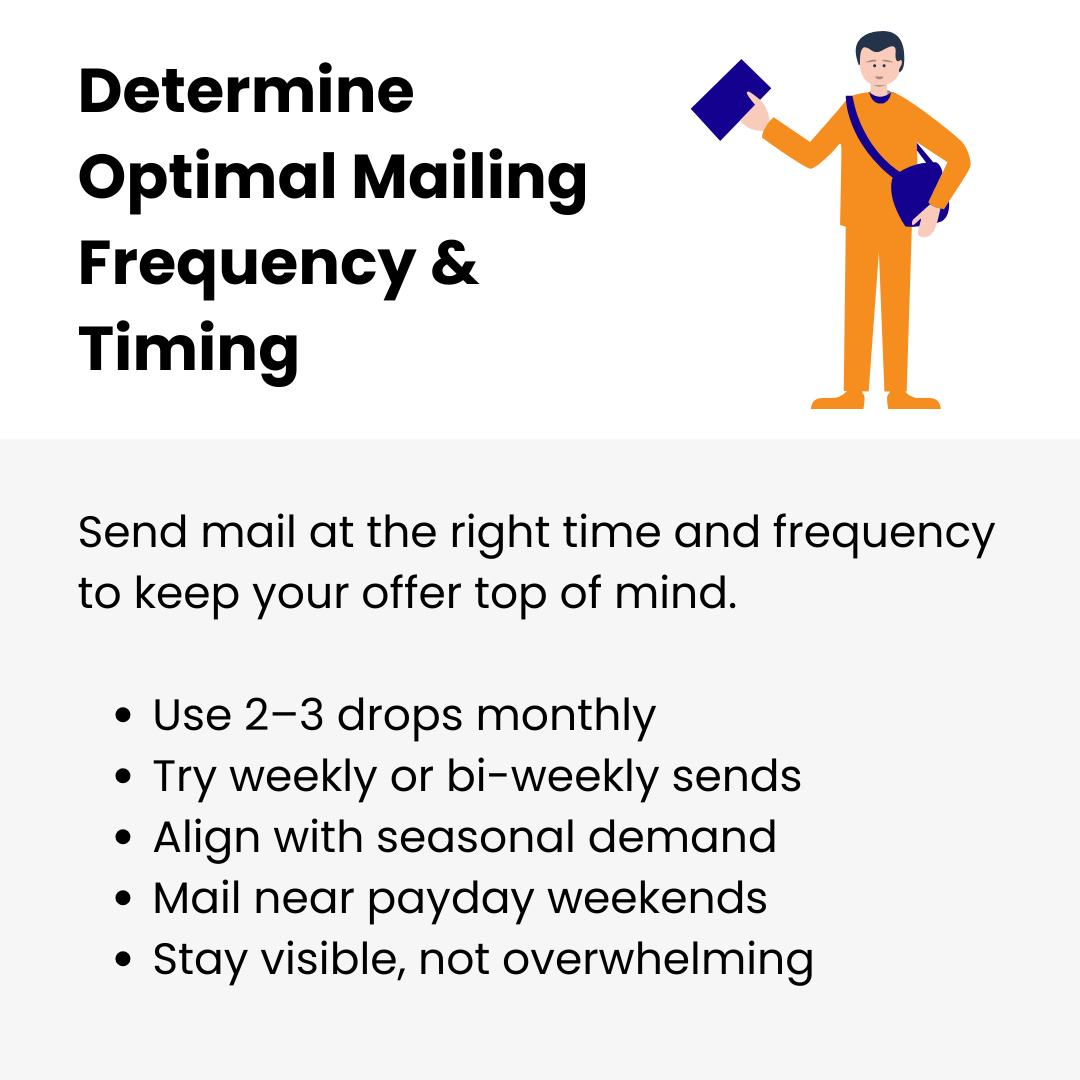
A single drop usually isn’t enough to make potential customers act. Mail gets noticed more when it shows up a few times, spaced out just right. For a small campaign, two to three drops across a month works better than one big blast.
- Weekly or bi-weekly drops across the same routes keep your offer visible without overwhelming direct mail recipients.
- Seasonal businesses should schedule campaigns around peak demand. For example, lawn care right before spring or holiday catering two weeks before December events.
- Track your own local calendar. Mailing right after payday weekends boosts redemption for service-based offers.
Of course, this kind of precision matters across all industries, but it becomes absolutely critical when you are dealing with life-saving products. Take medical alert systems, for example. Families don’t just see one ad and place an order the same day. The decision carries weight because someone’s life may depend on it. That is why consistent exposure is so powerful.
When people are choosing mobile personal emergency response systems, they need to trust the brand. And trust doesn’t come from a single postcard or one online ad. It builds over time, as your name keeps showing up in the mailbox, and the design feels fresh each round.
That repeated presence makes your business look stable and dependable – two qualities buyers value most when the stakes are high. And here’s where POD combined with EDDM really works. You can adjust the message slightly each mailing – maybe one round focuses on reliability, the next on ease of use, and another on customer support.
By the time someone is ready to make the purchase, they have already connected your brand with safety and credibility.
6. Coordinate POD Production With EDDM Mailing Schedules
Print-on-demand gives you flexibility, but timing is everything. USPS has specific drop-off requirements, and if production is late, your campaign stalls. Always work backward from your planned drop date.
- Place your POD orders at least 2–3 days before the planned USPS acceptance date.
- Confirm the printer’s turnaround time and shipping speed to the local USPS entry unit.
- For recurring campaigns, set up a repeating order schedule so new batches roll off automatically.
7. Test Multiple Designs With Small Batch Mailings
Making random calls on design is a fast way to waste money. POD makes testing cheap, so use it. Print a few hundred of two or three variations and spread them across different routes.
Here’s an example setup:
- Version A: bold headline, minimal copy.
- Version B: lifestyle image, short benefit statement.
- Version C: heavy offer focus with a coupon.
Track which one pulls better. The winner becomes your template for larger runs. This way, every campaign doubles as research instead of just spending.
In some industries, if you skip testing and go with the wrong design, it can actually hurt your reputation. Let’s take the example of this emergency notification app from DialMyCalls. If they decide to run a POD + EDDM campaign in their local community, the way they frame their message matters a lot.
One design focuses too much on flashy graphics, but downplays how quickly the app can send alerts. Another puts all the emphasis on price, but forgets to highlight reliability. Both versions miss the mark.
If those mailers hit the wrong note, the audience might think the app is just another generic tool and not the reliable safety net it actually is. For a product tied directly to emergencies, that is a big problem – you don’t want your first impression to create doubt.
The smarter move is to use POD for what it is best at: low-risk testing. Send a smaller batch of each design, track the responses, and pay attention to what actually makes sense to the local community. That way, when you scale up, you are rolling out a proven message that builds trust instead of eroding it.
8. Track Responses & Measure Campaign Performance
Similar to digital channels, there is no way to tell what worked if you are not tracking. A simple system is enough, as long as it ties responses back to the mail piece.
Ways to track effectively:
- Assign unique coupon codes for each route.
- Use QR codes linked to route-specific landing pages.
- Track call volume with route-specific phone numbers. Use VoIP as a secure channel to capture responses while protecting your main contact.
At the end of the campaign, measure response rates against the goals you set in step one. If one route or design outperformed the rest, you have a proven direction for your next mailing.
Now, here’s where a lot of small businesses stall out. On paper, tracking sounds easy, but setting up and actually monitoring every bit takes extra hand. And if you try to do it yourself, it slows everything down.
That is why it helps to augment your team just for this part of the job. Bring in a marketing assistant who can get everything done without distracting your main team, and you still end up with the insight you need to make sharper decisions for the next round.
5 Types Of Print‑on‑Demand Materials Ideal For EDDM
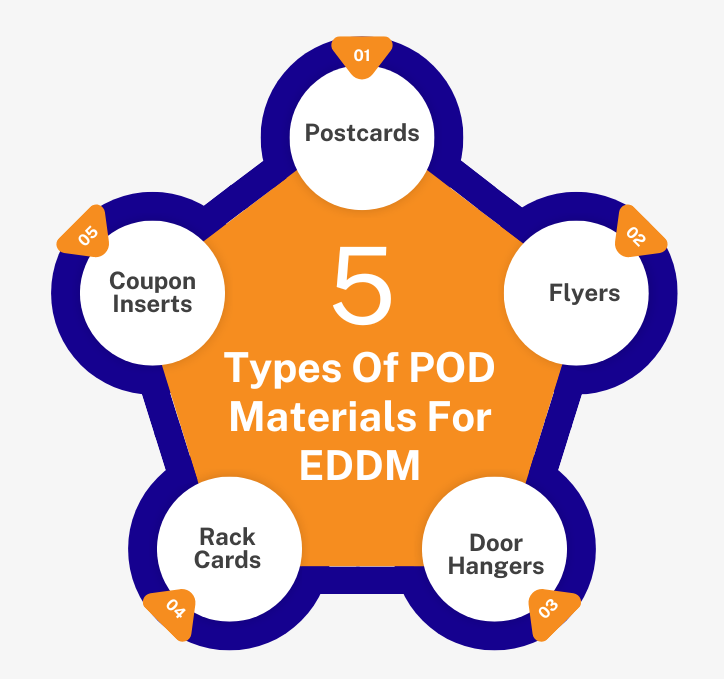
Just like in digital strategies, not every print piece works the same way. To help you pick smart, here are 5 types of print-on-demand materials that fit perfectly with EDDM marketing efforts.
1. Postcards
Postcards are the perfect format for EDDM because they qualify for the lowest postage rates and hit the mailbox without an envelope hiding them. For small campaigns, oversized postcards (6.5” x 9” or bigger) usually get noticed faster than standard ones. They are best for straightforward offers like “20% off this month” or “Grand Opening.”
Pro Tip: Keep the headline short and bold on one side. Save details for the back. Don’t overload both sides – it weakens impact.
2. Flyers
Flyers give you more room when you need to explain something, like service menus, class schedules, or event lineups. They fold easily, so you can tuck in sections for different information. Flyers work well in neighborhoods where people might pin them to a fridge or bulletin board.
Pro Tip: When designing a flyer, use one clear section for the main offer and a secondary section for details. Too much text everywhere, and the piece goes unread.
3. Door Hangers
Door hangers don’t go through the mailbox, but they are still deliverable through targeted routes if you want to supplement EDDM. They are harder to ignore because they hang right at eye level. Restaurants, cleaning services, and local repair businesses see higher pickup rates with door hangers.
Pro Tip: Make the hole punch reinforced so it doesn’t tear. And always put the call-to-action at the bottom, where hands naturally land when removing it.
4. Rack Cards
Rack cards are slim but sturdy, which makes them perfect for concise messaging. They stand out in the stack of typical mail because of their vertical shape. They work best when you are pushing one or two services and don’t need a ton of copy.
Pro Tip: Use thick stock so they don’t bend. Keep the front clean with one key message. Put the fine print or extras on the back.
5. Coupon Inserts
If the goal is quick response, coupons do the job. POD makes it easy to test different versions ($5 off vs. 10% off) and see what actually gets redeemed. They are small, but people keep them longer than a flyer if the offer is good.
Pro Tip: Always add an expiration date. It creates urgency and also makes it easier to measure redemption within your campaign window.
Conclusion
The real benefits of combining print on demand with EDDM come down to control. You decide how many pieces leave the printer, and you choose exactly which routes will see your message. That is the flexibility most small campaigns rarely get. So to get the most out of these marketing channels, keep goals realistic and tweak things based on the results.
If you need someone to make the whole process easier, we at Catdi Printing can help. We’re a true one-stop print + EDDM shop, covering everything from postcards and flyers to door hangers and rack cards. Fast turnaround, affordable pricing, and human-centered service mean you get your campaign rolling without headaches.
Reach out now and get a free quote to put your next campaign in motion.

